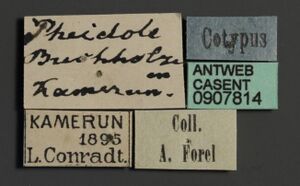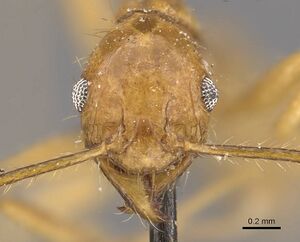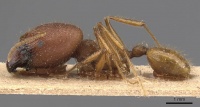Pheidole buchholzi
| Pheidole buchholzi | |
|---|---|

| |
| Scientific classification | |
| Kingdom: | Animalia |
| Phylum: | Arthropoda |
| Class: | Insecta |
| Order: | Hymenoptera |
| Family: | Formicidae |
| Subfamily: | Myrmicinae |
| Tribe: | Attini |
| Genus: | Pheidole |
| Species: | P. buchholzi |
| Binomial name | |
| Pheidole buchholzi Mayr, 1901 | |
Identification
Distribution
Latitudinal Distribution Pattern
Latitudinal Range: 6.5° to 5.343472°.
| North Temperate |
North Subtropical |
Tropical | South Subtropical |
South Temperate |
- Source: AntMaps
Distribution based on Regional Taxon Lists
Afrotropical Region: Cameroun (type locality), Guinea, Ivory Coast.
Distribution based on AntMaps
Distribution based on AntWeb specimens
Check data from AntWeb
Countries Occupied
| Number of countries occupied by this species based on AntWiki Regional Taxon Lists. In general, fewer countries occupied indicates a narrower range, while more countries indicates a more widespread species. |

|
Estimated Abundance
| Relative abundance based on number of AntMaps records per species (this species within the purple bar). Fewer records (to the left) indicates a less abundant/encountered species while more records (to the right) indicates more abundant/encountered species. |

|
Biology
Castes
Images from AntWeb
   
| |
| Syntype of Pheidole buchholzi. Worker. Specimen code casent0907814. Photographer Will Ericson, uploaded by California Academy of Sciences. | Owned by MHNG, Geneva, Switzerland. |
Nomenclature
The following information is derived from Barry Bolton's Online Catalogue of the Ants of the World.
- buchholzi. Pheidole buchholzi Mayr, 1901a: 276 (s.w.) CAMEROUN. Forel, 1916: 413 (q.).
Description
References
- Forel, A. 1916. Fourmis du Congo et d'autres provenances récoltées par MM. Hermann Kohl, Luja, Mayné, etc. Rev. Suisse Zool. 24: 397-460 (page 413, queen described)
- Mayr, G. 1901a [1900]. Drei neue Formiciden aus Kamerun gesammelt von Herrn Prof. Dr. Reinhold Buchholz. Entomol. Tidskr. 21: 273-279 (page 276, soldier, worker described)
References based on Global Ant Biodiversity Informatics
- Bernard F. 1953. La réserve naturelle intégrale du Mt Nimba. XI. Hyménoptères Formicidae. Mémoires de l'Institut Français d'Afrique Noire 19: 165-270.
- Eidmann H. 1944. Die Ameisenfauna von Fernando Poo. 27. Beitrag zu den Ergebnissen der Westafrika-Expedition. Zool. Jahrb. Abt. Syst. Ökol. Geogr. Tiere 76: 413-490.
- Forel A. 1910. Note sur quelques fourmis d'Afrique. Annales de la Société Entomologique de Belgique 54: 421-458.
- Kone M., S. Konate, K. Yeo, P. K. Kouassi, K. E. Linsemair. 2010. Diversity and abundance of terrrestrial ants along a gradient of land use intensification in a transitional forest-savannah zone of Cote d'Ivoire. Journal of Applied Biosciences 29: 1809-1827.
- Kone M., S. Konate, K. Yeo, P. K. Kouassi, and K. E. Linsenmair. 2012. Changes in ant communities along an age gradient of cocoa cultivation in the Oumé region, central Côte dIvoire. Entomological Science 15: 324339.
- Lévieux J. 1977. La nutrition des fourmis tropicales: V- Elements de synthèse. Les modes d'exploitation de la biocenose. Insectes Sociaux 24(3): 235-260.
- Menozzi C. 1942. Formiche dell'isola Fernando Poo e del territorio del Rio Muni (Guinea Spagnola). 24. Beitrag zu den wissenschaftlichen Ergebnissen der Forschungsreise H. Eidmann nach Spanisch-Guinea 1939 bis 1940. Zoologischer Anzeiger 140: 164-182.
- Yeo K., L. M. M. Kouakou, W. Dekoninck, K. Ouattara, and S. Konate. 2016. Detecting intruders: assessment of the anthropophilic ant fauna (Hymenoptera: Formicidae) in the city of Abidjan and along access roads in Banco National Park (Côte d’Ivoire). Journal of Entomology and Zoological Studies 4(4): 351-359.
- Yeo K., S. Konate, S. Tiho, and S. K. Camara. 2011. Impacts of land use types on ant communities in a tropical forest margin (Oumé - Cote d'Ivoire). African Journal of Agricultural Research 6(2): 260-274.
- Yeo K., and A. Hormenyo. 2007. A Rapid Survey of Ants in Ajenjua Bepo and Mamang River Forest Reserves, Eastern Region of Ghana. Pp 27-29. In McCullough, J., P. Hoke, P. Naskrecki, and Y. Osei-Owusu (eds.). 2008. A Rapid Biological Assessment of the Ajenjua Bepo and Mamang River Forest Reserves, Ghana. RAP Bulletin of Biological Assessment 50. Conservation International, Arlington, VA, USA.

